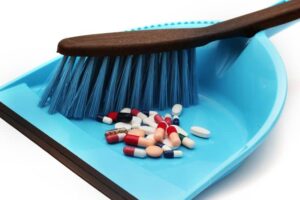Welcome to our informative journey into the world of pharmaceutical pollution, a topic that's starting to make waves in environmental circles and beyond. Today, you're in for a deep dive into some truly innovative solutions aimed at curbing this issue, and how raising public awareness plays a critical role in tackling it.
From the impact on urban waters and the Great Lakes to the promising technique of ozonation and the role of the pharmaceutical industry, we've got it covered. So, gear up for a presentation packed with insights, including a map of pharmaceutical pollution hotspots, and ready yourself for actionable campaign ideas. Let's make a difference together.
Pharmaceutical Pollution Research: A Deep Dive into Impact and Solutions
The quest to understand the scope and impact of pharmaceutical pollution has surged in recent years. Initiatives focusing on pharmaceutical pollution research have shed light on how residues from medications end up in our environment, affecting ecosystems and human health.
 This contamination occurs at various stages – from production through to disposal. Research highlights that traditional water treatment methods may not fully eradicate these compounds, leading to their accumulation in urban waters and even in more secluded areas such as the Great Lakes.
This contamination occurs at various stages – from production through to disposal. Research highlights that traditional water treatment methods may not fully eradicate these compounds, leading to their accumulation in urban waters and even in more secluded areas such as the Great Lakes.
Recognizing the gaps, scientists and environmentalists are exploring innovative solutions, such as advanced filtration systems and bioremediation techniques, to address this invisible menace. By prioritizing research and implementing findings, we can take significant strides towards minimizing the environmental footprint of our healthcare practices.
Understanding Pharmaceutical Pollution in Urban Waters and the Great Lakes
When we dive into the issue of pharmaceutical pollution in urban waters and its presence in the Great Lakes, it becomes evident that our cities and natural bodies of water are silently suffering.
Urban waters, often the endpoints of sewage and industrial waste streams, turn into reservoirs for various pharmaceutical compounds.
Similarly, the iconic Great Lakes are not immune, with ongoing research revealing detectable levels of medication residue. Such pollution poses risks to aquatic life, altering ecosystems and potentially entering our drinking water. Raising awareness and understanding the intricacies of how pharmaceuticals travel from our homes to these waters is the first step towards mitigation. Enhanced sewage treatment and responsible medication disposal are vital steps in safeguarding these precious water resources.
Mapping the Unseen: A Comprehensive Look at Pharmaceutical Pollution Hotspots
In tackling pharmaceutical pollution, identifying the most affected areas is crucial.
 This is where a pharmaceutical pollution map becomes an invaluable tool. By pinpointing pollution hotspots, researchers and policymakers can focus their efforts more efficiently. These maps reveal not only urban centers with high levels of pharmaceutical waste but also rural areas where agricultural run-off contributes to the problem.
This is where a pharmaceutical pollution map becomes an invaluable tool. By pinpointing pollution hotspots, researchers and policymakers can focus their efforts more efficiently. These maps reveal not only urban centers with high levels of pharmaceutical waste but also rural areas where agricultural run-off contributes to the problem.
Understanding the geography of pharmaceutical pollution aids in tailoring clean-up and prevention strategies to specific needs. Such mapping encourages community involvement, as locals become aware of the pollution levels in their vicinity and are thus more likely to engage in solutions.
Innovative Techniques like Ozonation: The Future of Combating Pharmaceutical Pollution
As we scour for solutions to reduce pharmaceutical pollution, one technique stands out: ozonation.
This advanced treatment method involves the use of ozone gas to break down pharmaceutical contaminants in water. The beauty of ozonation lies in its effectiveness in degrading even those compounds that traditional treatments cannot touch.
By integrating ozonation into wastewater treatment plants, we can significantly reduce the volume of pharmaceutical residues released into the environment. This innovative technique highlights the potential of combining science and technology to address complex environmental challenges, offering a beacon of hope for cleaner, safer waters.
The Role of the Pharmaceutical Industry in Water Pollution: From Awareness to Action
The pharmaceutical industry plays a dual role in the narrative of water pollution.
 On one hand, it's the source of life-saving medicines; on the other, it contributes to water pollution. However, recognizing its impact, the industry is starting to act. There's a growing trend towards greener production processes and the implementation of water pollution campaign ideas focusing on reducing waste and enhancing drug take-back programs.
On one hand, it's the source of life-saving medicines; on the other, it contributes to water pollution. However, recognizing its impact, the industry is starting to act. There's a growing trend towards greener production processes and the implementation of water pollution campaign ideas focusing on reducing waste and enhancing drug take-back programs.
These initiatives not only aim to minimize the industry's environmental footprint but also to engage consumers in responsible medication disposal. This shift towards sustainability demonstrates a commitment to tackling pharmaceutical pollution at its source, offering a model for how industries can move from awareness to meaningful action.
Powerful Presentations: Utilizing Slides and PowerPoints to Raise Awareness about Pharmaceutical Pollution
Effective communication is key to raising awareness about pharmaceutical pollution.
Utilizing tools like PowerPoint presentations and informative slides, environmental advocates can reach a broad audience, from school children to policymakers. These presentations break down complex data into digestible pieces, illustrating the journey of pharmaceuticals from production to pollution.
By highlighting case studies, showcasing pollution maps, and presenting actionable solutions, these slides can inspire change.
Whether it's for an academic pharmaceutical pollution presentation or a community meeting, leveraging visual aids makes the message about the importance of tackling pharmaceutical pollution more compelling and accessible to all.
